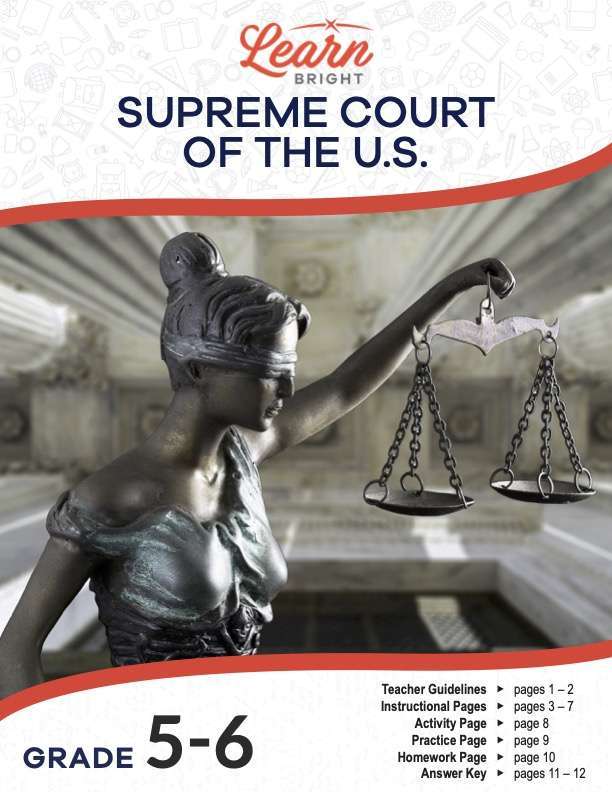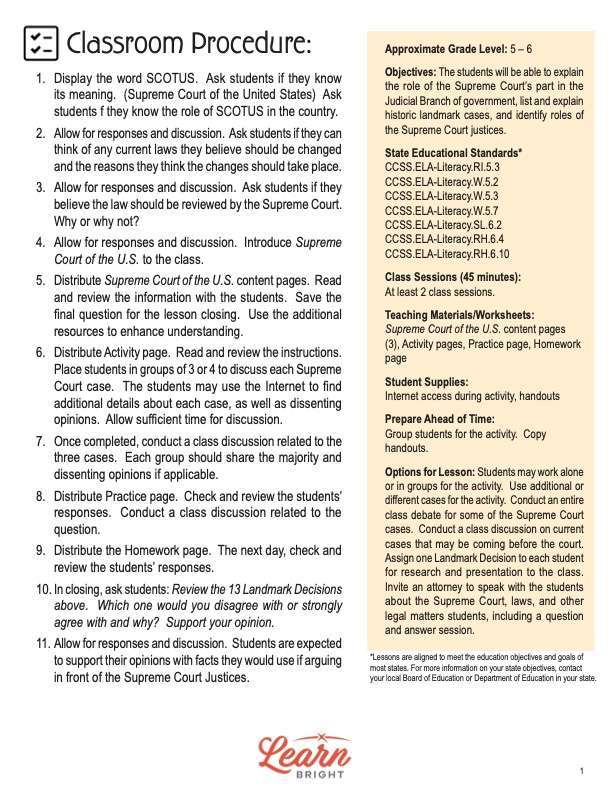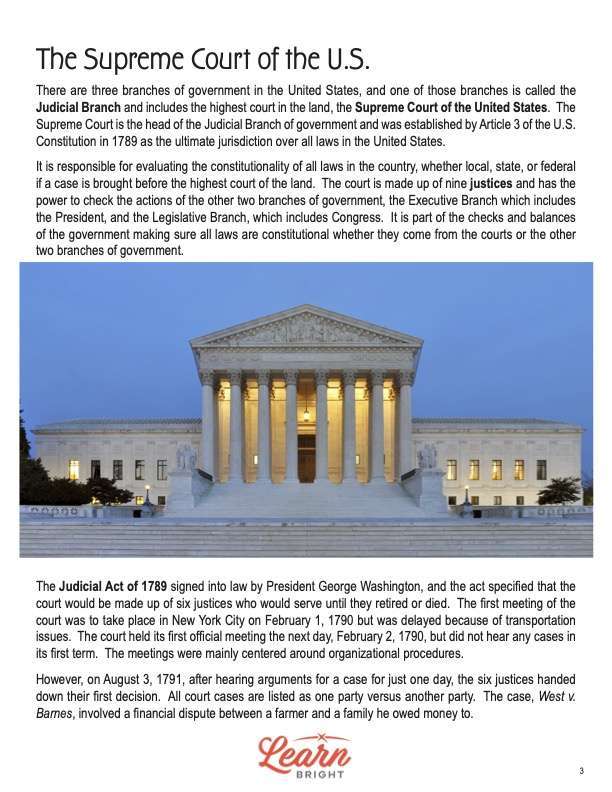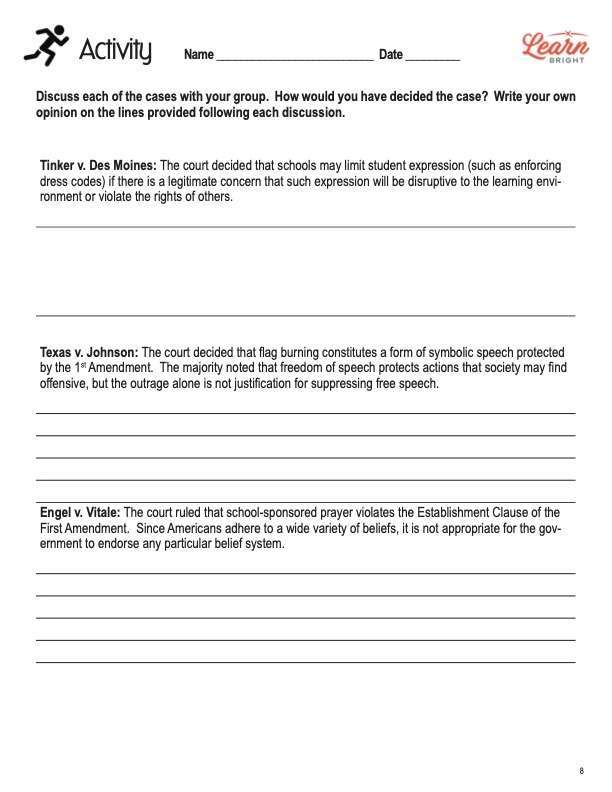Description
What our Supreme Court of the U.S. lesson plan includes
Lesson Objectives and Overview: Supreme Court of the U.S. teaches 5th and 6th grade students about this essential part of the nation’s government. Students will learn about the judicial branch and some historic landmark cases that shaped society. They will also be able to identify and explain the roles of the Supreme Court justices. This lesson is for students in 5th grade and 6th grade.
Classroom Procedure
Every lesson plan provides you with a classroom procedure page that outlines a step-by-step guide to follow. You do not have to follow the guide exactly. The guide helps you organize the lesson and details when to hand out worksheets. It also lists information in the yellow box that you might find useful. You will find the lesson objectives, state standards, and number of class sessions the lesson should take to complete in this area. In addition, it describes the supplies you will need as well as what and how you need to prepare beforehand.
Options for Lesson
The “Options for Lesson” section of the classroom procedure page lists a number of suggestions for ideas and activities you could incorporate into the lesson. Students may work alone or in groups for the activity. Use additional or different cases for the activity. Conduct an entire class debate for some of the Supreme Court cases. Conduct a class discussion on current cases that may be coming before the court. Assign one landmark decision to each student for research that they can later present to the class. Invite an attorney to speak with the students about the Supreme Court, laws, and other legal matters, and include a question and answer session.
Teacher Notes
The paragraph on this page gives you a little more information on the lesson overall and describes what you may want to focus your teaching on. It explains how some students may not fully understand the influence of the Supreme Court on the lives of the country’s citizens. The blank lines are available for you to write out any thoughts or ideas you have as you prepare.
SUPREME COURT OF THE U.S. LESSON PLAN CONTENT PAGES
Introduction to the Supreme Court
The Supreme Court of the U.S. lesson plan contains four content pages. There are three branches of government in the United States. One of those branches is the judicial branch, which includes the highest court in the land, the Supreme Court of the United States. The Supreme Court is the head of the judicial branch of government. In 1789, Article 3 of the U.S. Constitution established the Supreme Court as the ultimate jurisdiction over all laws in the United States.
It is responsible for evaluating the constitutionality of all laws in the country—whether local, state, or federal—if a case is brought before them. Nine justices make up the court. They have the power to check the actions of the other two branches of government—executive and legislative. The executive branch includes the president, and the legislative branch includes Congress. The Supreme Court is part of the “checks and balances” of the government, making sure all laws are constitutional, whether they come from the courts or from the other two branches.
President George Washington signed into law the Judicial Act of 1789. The act specified that the court would be made up of six justices who would serve until they retired or died. The first meeting of the court was to take place in New York City on February 1, 1790, but was delayed because of transportation issues. The court held its first official meeting the next day, February 2, 1790. However, it did not hear any cases in its first term. The meetings were mainly centered around organizational procedures.
On August 3, 1791, after hearing arguments for a case for just one day, the six justices handed down their first decision. All court cases are listed as one party versus another party. This case, West v. Barnes, involved a financial dispute between a farmer and a family to whom he owed money.
Notable Justices of the Supreme Court
The chief justice of the court is responsible for leading the court, setting the agenda, and assigning others to write the court’s opinions in cases that are brought before them. The chief justice also presides over impeachment trials against the President in the U.S. Senate. This has occurred two times in history; the first with President Andrew Johnson and the second President Bill Clinton. Following both trials, the presidents were acquitted or found not guilty of any wrongdoing.
The court began with six justices in 1790 but has changed from a low of five to a high of ten throughout its existence over the course of more than 200 years. In 1869, Congress set the number of seats to nine, and as of 2023, it has remained nine. In all, as of March of 2023, there have been 116 Justices who have served on the Supreme Court. The current (2023) Chief Justice of the Supreme Court is John Roberts, Jr.
John Marshall served the longest term of any chief justice—34 years—and is regarded as one of the most influential. Earl Warren is another notable justice who issued decisions related to laws that banned school segregation, Miranda rights, and the abolition of interracial marriage prohibitions. Until this point, people of different races could not legally marry.
Thurgood Marshall was the first African American justice on the Supreme Court. He joined the court in 1967. Sandra Day O’Connor was the first female justice, appointed in 1981. And Sonia Sotomayor became the first Hispanic justice to sit on the Supreme Court in 2009.
Landmark Decisions
Since 1925, the Supreme Court has had the discretion in most instances to decide whether to hear a case or not. The court usually agrees to hear about 100 to 150 cases out of around 7,000 it is asked to review each year. Most of the cases they do not review are sent back to the preceding court, or the previous decision simply stands as ruled.
Nearly all the decisions the Supreme Court makes have an impact on persons related to the case. However, many decisions have a greater impact and influence in shaping the nation and society and often affect nearly all citizens of the United States. We call such decisions landmark decisions. Some have been more important than others. The lesson provides a list of landmark decisions that most experts agree are very important.
One was Dred Scott v. Sandford, in which the Supreme Court ruled that the Constitution did not consider slaves to be American citizens. The 13th Amendment later overturned this decision. In Gideon v. Wainwright, Clarence Gideon could not afford an attorney. The court ruled that defendants in criminal cases have the right to free counsel.
The list includes 13 landmark decisions, but there have been several other cases that have influenced the citizens throughout the United States. Some cases have confirmed or clarified various parts of the Constitution. For instance, cases have confirmed an individual’s right to own a gun or allowed interracial marriage. Other cases permitted police to stop and frisk a person if there is a reasonable suspicion that a crime has occurred or is about to occur. There was also a ruling that stated the president is not above the law.
SUPREME COURT OF THE U.S. LESSON PLAN WORKSHEETS
The Supreme Court of the U.S. lesson plan includes three worksheets: an activity worksheet, a practice worksheet, and a homework assignment. Each one will help students solidify their grasp of the material they learned throughout the lesson. You can refer to the classroom procedure guidelines to know when to hand out each worksheet.
YOU’RE THE JUDGE ACTIVITY
You will divide students into groups for the activity portion. There are three cases on the worksheet that students will study. They will discuss the cases with their group and explain how they would decide the case. Each student will write their opinion for each case in the space provided.
MATCH THE PERSON PRACTICE WORKSHEET
For the practice worksheet, students will first match information to the person it describes. There is a total of 10 descriptions and people to match. Then, students will write a question that corresponds to a clue (e.g., Landmark, Judicial, Article 3). Last, they will describe the landmark decision they believe had the greatest impact on society. You may have students share these responses with the class.
SUPREME COURT OF THE U.S. HOMEWORK ASSIGNMENT
The homework assignment requires students to match case names to the correct ruling. The worksheet lists all 13 landmark decisions. Afterward, they will mark six different statements as true (T) or false (F).
Worksheet Answer Keys
There are answer keys for both the practice and homework worksheets at the end of the lesson plan. The correct answers are in red to make it easy to compare them to students’ responses. If you choose to administer the lesson pages to your students via PDF, you will need to save a new file that omits these pages. Otherwise, you can simply print out the applicable pages and keep these as reference for yourself when grading assignments.









